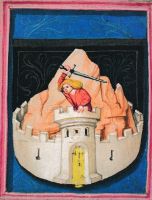Hüttenberg (Kärnten): Difference between revisions
Jump to navigation
Jump to search
Knorrepoes (talk | contribs) m (Text replacement - "50 px|Link=KärntenCategory:Kärnten↵↵[[Category:" to "Category:Kärnten [[Category:") |
Knorrepoes (talk | contribs) No edit summary |
||
| Line 1: | Line 1: | ||
{{ | {| class="wikitable" | ||
|- style="vertical-align:top;" | |||
|[[File:huttenbe.jpg|center|300 px|alt=Wappen von {{PAGENAME}}/Arms (crest) of {{PAGENAME}}]] | |||
| | |||
'''Country''' : Austria [[File:Austria.jpg|60 px|right]]<br><br><br> | |||
'''State''' : [[Kärnten]][[File:Karnten.jpg|60 px|right]]<br><br><br> | |||
'''District ''' : Sankt Veit an der Glan | |||
{{#display_map:46.9393,14.5483|width=250|height=250|zoom=7}} | |||
|} | |||
{| class="wikitable" | {| class="wikitable" | ||
| Line 12: | Line 14: | ||
|- | |- | ||
|'''German''' | |'''German''' | ||
| | | In schwarzem Schild ein Eisenspatfelsen von natürlicher Farbe, der von Grund auf mit einer natürlich gefärbten Zinnenmauer umgeben ist; in deren Mittelteil wächst aus einem bezinnten Torturm mit geschlossenem goldenen Tor ein rot bekleideter Mann mit blondem Haar, der mit einem bloßen Schwert zum Schlage ausholt. | ||
|- | |- | ||
|'''English''' | |'''English''' | ||
| | | blazon wanted | ||
|} | |} | ||
===Origin/meaning=== | ===Origin/meaning=== | ||
The arms were granted on June 20, 1492. | The arms were granted on June 20, 1492 by Emperor Friedrich III. | ||
The arms are canting, in the dialect. According to legend, the name of Hüttenberg was derived from "Hiat den Berg", guard the mountain (where the important iron ore was mined). So, the arms show a wall, a tower and a man brandishing a sword. Near Hüttenberg, the Heft valley was a core of smelting and working iron. The mine (Hüttenberger Erzberg) was only closed down in the 1970s. | |||
<gallery widths=250px heights=200px perrow=0> | |||
File:huttenberg1.jpg|alt=Wappen von Hüttenberg/Arms (crest) of Hüttenberg|The arms on the original grant from 1492 | |||
</gallery> | |||
[[Civic Heraldry Literature - Austria|Literature]] : Zaisberger, F. and Pfeiffer, N. : Salzburger Gemeindewappen. Winter Verlag, Salzburg, 1985 | [[Civic Heraldry Literature - Austria|Literature]] : Zaisberger, F. and Pfeiffer, N. : Salzburger Gemeindewappen. Winter Verlag, Salzburg, 1985 | ||
Revision as of 10:27, 9 April 2023
|
Country : Austria State : Kärnten District : Sankt Veit an der Glan |
| German | In schwarzem Schild ein Eisenspatfelsen von natürlicher Farbe, der von Grund auf mit einer natürlich gefärbten Zinnenmauer umgeben ist; in deren Mittelteil wächst aus einem bezinnten Torturm mit geschlossenem goldenen Tor ein rot bekleideter Mann mit blondem Haar, der mit einem bloßen Schwert zum Schlage ausholt. |
| English | blazon wanted |
Origin/meaning
The arms were granted on June 20, 1492 by Emperor Friedrich III.
The arms are canting, in the dialect. According to legend, the name of Hüttenberg was derived from "Hiat den Berg", guard the mountain (where the important iron ore was mined). So, the arms show a wall, a tower and a man brandishing a sword. Near Hüttenberg, the Heft valley was a core of smelting and working iron. The mine (Hüttenberger Erzberg) was only closed down in the 1970s.
Literature : Zaisberger, F. and Pfeiffer, N. : Salzburger Gemeindewappen. Winter Verlag, Salzburg, 1985



